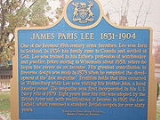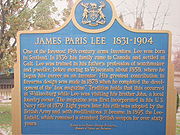
James Paris Lee
Encyclopedia
James Paris Lee was a Scottish-Canadian and later American inventor and arms
designer, best known for inventing the bolt action that led to the Lee-Metford
and Lee-Enfield
series of rifle
s.
, Scotland
Lee emigrated with his family to Galt, Ontario
in Canada
in 1836 at age 5. He built his first gun at the age of 12, using an old horse-pistol barrel, a newly carved walnut
stock, and a priming pan made from a halfpenny. The gun failed to function effectively when first fired, but started Lee's interest in gunsmithing and invention.
In 1858, James Lee and his wife Caroline Lee (née Chrysler, of the later automotive family) moved to Wisconsin
, where they had two sons- William (born in 1859) and George (1860).
In 1861, Lee successfully developed a breechloading cartridge conversion for the Springfield Model 1861
Rifled Musket, managing to acquire a contract for 1,000 rifles from the US Army during the American Civil War
. The Lee civil War carbine was manufactured in Milwaukee, WI. 200 were delivered, but due to a bore diameter error, these were rejected by the army and the weapon did not see use in the Civil War. These guns are rare and highly collectible.
Concurrently, Lee independently developed an en bloc charger-loaded magazine along the lines of the system developed by Ferdinand von Mannlicher
, which was used in the M1895 Lee Navy
rifle adopted by the U.S. Navy. In 1891, Lee unsuccessfully sued von Mannlicher, claiming that the latter's design infringed upon his en bloc magazine patent.
The Lee Model 1879 rifle, a landmark rifle design, incorporated a turnbolt action and the Lee spring-loaded column-feed magazine system, and was his first successful magazine-fed rifle. The Model 1879 was adopted by China
and the US Navy
, and two later designs - the Remington-Lee M1885
and the Winchester-Lee or Lee Navy M1895
- were also adopted militarily and sold commercially.
 His bolt and magazine design soon interested British ordnance authorities, and in 1889, after extensive trials, the British Army
His bolt and magazine design soon interested British ordnance authorities, and in 1889, after extensive trials, the British Army
decided to adopt the Rifle, Magazine, Lee-Metford as a standard issue arm. This in turn developed into the Rifle, Short, Magazine, Lee-Enfield (or SMLE), the British service arm for many decades.
James Paris Lee died in New York
on February 24, 1904, having lived to see his rifles in service throughout several Colonial conflicts and the Boer War
- yet no doubt completely unaware that his contribution would still be in official service 100 years later.
Weapon
A weapon, arm, or armament is a tool or instrument used with the aim of causing damage or harm to living beings or artificial structures or systems...
designer, best known for inventing the bolt action that led to the Lee-Metford
Lee-Metford
The Lee-Metford rifle was a bolt action British army service rifle, combining James Paris Lee's rear-locking bolt system and ten-round magazine with a seven groove rifled barrel designed by William Ellis Metford...
and Lee-Enfield
Lee-Enfield
The Lee-Enfield bolt-action, magazine-fed, repeating rifle was the main firearm used by the military forces of the British Empire and Commonwealth during the first half of the 20th century...
series of rifle
Rifle
A rifle is a firearm designed to be fired from the shoulder, with a barrel that has a helical groove or pattern of grooves cut into the barrel walls. The raised areas of the rifling are called "lands," which make contact with the projectile , imparting spin around an axis corresponding to the...
s.
Early Life and Career
Born in HawickHawick
Hawick is a town in the Scottish Borders of south east Scotland. It is south-west of Jedburgh and south-southeast of Selkirk. It is one of the farthest towns from the sea in Scotland, in the heart of Teviotdale, and the biggest town in the former county of Roxburghshire. Hawick's architecture is...
, Scotland
Scotland
Scotland is a country that is part of the United Kingdom. Occupying the northern third of the island of Great Britain, it shares a border with England to the south and is bounded by the North Sea to the east, the Atlantic Ocean to the north and west, and the North Channel and Irish Sea to the...
Lee emigrated with his family to Galt, Ontario
Ontario
Ontario is a province of Canada, located in east-central Canada. It is Canada's most populous province and second largest in total area. It is home to the nation's most populous city, Toronto, and the nation's capital, Ottawa....
in Canada
Canada
Canada is a North American country consisting of ten provinces and three territories. Located in the northern part of the continent, it extends from the Atlantic Ocean in the east to the Pacific Ocean in the west, and northward into the Arctic Ocean...
in 1836 at age 5. He built his first gun at the age of 12, using an old horse-pistol barrel, a newly carved walnut
Walnut
Juglans is a plant genus of the family Juglandaceae, the seeds of which are known as walnuts. They are deciduous trees, 10–40 meters tall , with pinnate leaves 200–900 millimetres long , with 5–25 leaflets; the shoots have chambered pith, a character shared with the wingnuts , but not the hickories...
stock, and a priming pan made from a halfpenny. The gun failed to function effectively when first fired, but started Lee's interest in gunsmithing and invention.
In 1858, James Lee and his wife Caroline Lee (née Chrysler, of the later automotive family) moved to Wisconsin
Wisconsin
Wisconsin is a U.S. state located in the north-central United States and is part of the Midwest. It is bordered by Minnesota to the west, Iowa to the southwest, Illinois to the south, Lake Michigan to the east, Michigan to the northeast, and Lake Superior to the north. Wisconsin's capital is...
, where they had two sons- William (born in 1859) and George (1860).
In 1861, Lee successfully developed a breechloading cartridge conversion for the Springfield Model 1861
Springfield Model 1861
The Springfield Model 1861 was a Minié-type rifled musket shoulder arm used by the United States Army and Marine Corps during the American Civil War. Commonly referred to as the "Springfield" , it was the most widely used U.S...
Rifled Musket, managing to acquire a contract for 1,000 rifles from the US Army during the American Civil War
American Civil War
The American Civil War was a civil war fought in the United States of America. In response to the election of Abraham Lincoln as President of the United States, 11 southern slave states declared their secession from the United States and formed the Confederate States of America ; the other 25...
. The Lee civil War carbine was manufactured in Milwaukee, WI. 200 were delivered, but due to a bore diameter error, these were rejected by the army and the weapon did not see use in the Civil War. These guns are rare and highly collectible.
The Lee Magazine Systems and Rifles
Perhaps Lee's greatest individual impact on modern small arms development came with his invention for a spring-loaded column-feed magazine system for centerfire cartridge rifles. Fitted with a charger bridge, the Lee magazine could be quickly reloaded with either single cartridges, like a tubular feed magazine, or a charger of five rounds, like the Lee or Mannlicher en bloc systems. With the magazine detached, the rifle became a single-shot weapon, a feature seen as desirable by some countries for training purposes or for maintaining control over sometimes unreliable colonial or indigenous troops. The Lee magazine was also adaptable to a variety of cartridges and bolt systems regardless of bullet shape or cartridge length. Because the cartridges were stored in a column, the Lee magazine could be easily lengthened to store additional cartridges in keeping with evolving small arms doctrine. In combat, the detachable magazine theoretically allowed a soldier to carry multiple loaded magazines, thus speeding reloading time. Unfortunately, at the time Lee's magazine was introduced, rifle magazines were expensive to fabricate, and could not be regarded as expendable items. Lee's idea of carrying additional loaded magazines was not seen as an advantage by most major military forces at the time, who preferred to issue the soldier with loose cartridges or en bloc charger clips. However, in time Lee's detachable column-feed magazine system became the preeminent design used in all modern military small arms.Concurrently, Lee independently developed an en bloc charger-loaded magazine along the lines of the system developed by Ferdinand von Mannlicher
Ferdinand Mannlicher
Ferdinand Ritter von Mannlicher was an engineer and small armaments designer. Along with James Paris Lee, Mannlicher was particularly noted for inventing the en-bloc clip charger-loading magazine system...
, which was used in the M1895 Lee Navy
M1895 Lee Navy
The Lee Model 1895 was a straight-pull, cam-action magazine rifle adopted in limited numbers by the U.S. Navy and Marine Corps in 1895 as a first-line infantry rifle...
rifle adopted by the U.S. Navy. In 1891, Lee unsuccessfully sued von Mannlicher, claiming that the latter's design infringed upon his en bloc magazine patent.
The Lee Model 1879 rifle, a landmark rifle design, incorporated a turnbolt action and the Lee spring-loaded column-feed magazine system, and was his first successful magazine-fed rifle. The Model 1879 was adopted by China
China
Chinese civilization may refer to:* China for more general discussion of the country.* Chinese culture* Greater China, the transnational community of ethnic Chinese.* History of China* Sinosphere, the area historically affected by Chinese culture...
and the US Navy
United States Navy
The United States Navy is the naval warfare service branch of the United States Armed Forces and one of the seven uniformed services of the United States. The U.S. Navy is the largest in the world; its battle fleet tonnage is greater than that of the next 13 largest navies combined. The U.S...
, and two later designs - the Remington-Lee M1885
M1885 Remington-Lee
The M1885 Remington-Lee is a bolt action, box magazine repeating rifle designed principally by James Paris Lee. It first appeared in 1879, manufactured by the Sharps Rifle Manufacturing Company. Eventually Remington took over production and produced the famous Model 1885 Remington Lee Navy Rifle...
and the Winchester-Lee or Lee Navy M1895
M1895 Lee Navy
The Lee Model 1895 was a straight-pull, cam-action magazine rifle adopted in limited numbers by the U.S. Navy and Marine Corps in 1895 as a first-line infantry rifle...
- were also adopted militarily and sold commercially.


British Army
The British Army is the land warfare branch of Her Majesty's Armed Forces in the United Kingdom. It came into being with the unification of the Kingdom of England and Scotland into the Kingdom of Great Britain in 1707. The new British Army incorporated Regiments that had already existed in England...
decided to adopt the Rifle, Magazine, Lee-Metford as a standard issue arm. This in turn developed into the Rifle, Short, Magazine, Lee-Enfield (or SMLE), the British service arm for many decades.
James Paris Lee died in New York
New York
New York is a state in the Northeastern region of the United States. It is the nation's third most populous state. New York is bordered by New Jersey and Pennsylvania to the south, and by Connecticut, Massachusetts and Vermont to the east...
on February 24, 1904, having lived to see his rifles in service throughout several Colonial conflicts and the Boer War
Second Boer War
The Second Boer War was fought from 11 October 1899 until 31 May 1902 between the British Empire and the Afrikaans-speaking Dutch settlers of two independent Boer republics, the South African Republic and the Orange Free State...
- yet no doubt completely unaware that his contribution would still be in official service 100 years later.

